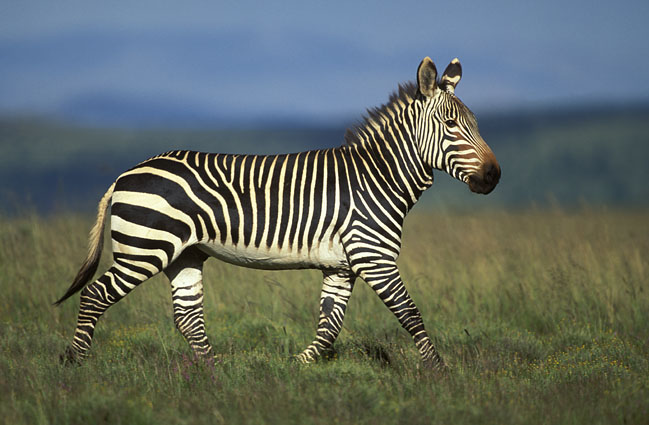Appearance
The distinctive stripes of the Burchell's zebra run diagonally and lengthways on the rump and continue on to the belly. On the rump there are usually chestnut or yellowish "shadow" stripes in the middle of the white stripes. Like human fingerprints and irises, each individual has a unique stripe pattern.
The muzzle is black. A short, stiff mane runs down the back of the neck and the tail has a whisk of long black hair on the end.The distinctive stripes of the Burchell's zebra run diagonally and lengthways on the rump and continue on to the belly. On the rump there are usually chestnut or yellowish "shadow" stripes in the middle of the white stripes. Like human fingerprints and irises, each individual has a unique stripe pattern.
Behaviour
Active in the cooler early morning and late afternoon. Drinks at least once a day and has a strong preference for clean water.
Stallions fight viciously for control of females. Males that do not hold breeding herds join bachelor herds with hierarchy depending on age.
If threatened by predators, herds flee in tight bunches. Herd stallions defend their groups by running in the rear as they flee, kicking and biting attackers.
Predators are much more successful if an individual zebra can be separated from the herd. The contrasting black and white stripes may help to confuse predators.
Reproduction
Single foals weighing 30-35kg (66-77lbs) are born at any time of year after a gestation of 360-390 days. Foals can stand after about 10 minutes, start eating grass within a few days and wean at 11 months.
Lions and spotted hyenas take adult zebras; foals are taken by lions, spotted hyenas, leopards and cheetahs.

Diet
Prefers short, green grass but will eat tall, coarse growth. An unselective bulk feeder, the zebra is less sensitive to food quality than other large herbivores and can maintain good body condition on very poor veld.
Sounds
The alarm call is a high-pitched, repeated two-syllable "kwa-hi". The sound is typical of the African bushveld and the colloquial name "quagga" is derived from it.
No comments:
Post a Comment